SUMMARY CMI
VEMLIDY®
Consumer Medicine Information (CMI) summary
The full CMI on the next page has more details. If you are worried about using this medicine, speak to your doctor or pharmacist.
1. Why am I using VEMLIDY?
VEMLIDY contains the active ingredient tenofovir alafenamide. VEMLIDY is used for the treatment of chronic (long-lasting) hepatitis B virus (HBV) in adults.
For more information, see Section 1. Why am I using VEMLIDY? in the full CMI.
2. What should I know before I use VEMLIDY?
Do not use if you have ever had an allergic reaction to VEMLIDY or any of the ingredients listed at the end of the CMI.
Talk to your doctor if you have any other medical conditions, take any other medicines, or are pregnant or plan to become pregnant or are breastfeeding.
For more information, see Section 2. What should I know before I use VEMLIDY? in the full CMI.
3. What if I am taking other medicines?
Some medicines may interfere with VEMLIDY and affect how it works.
A list of these medicines is in Section 3. What if I am taking other medicines? in the full CMI.
4. How do I use VEMLIDY?
- The usual dose is one VEMLIDY tablet orally, once daily.
More instructions can be found in Section 4. How do I use VEMLIDY? in the full CMI.
5. What should I know while using VEMLIDY?
| Things you should do |
|
| Things you should not do |
|
| Driving or using machines |
|
| Looking after your medicine |
|
For more information, see Section 5. What should I know while using VEMLIDY? in the full CMI.
6. Are there any side effects?
The most common side effect of VEMLIDY is nausea.
For more information, including what to do if you have any side effects, see Section 6. Are there any side effects? in the full CMI.
FULL CMI
VEMLIDY®
Active ingredient: tenofovir alafenamide
Consumer Medicine Information (CMI)
This leaflet provides important information about using VEMLIDY. You should also speak to your doctor or pharmacist if you would like further information or if you have any concerns or questions about using VEMLIDY.
Where to find information in this leaflet:
1. Why am I using VEMLIDY?
2. What should I know before I use VEMLIDY?
3. What if I am taking other medicines?
4. How do I use VEMLIDY?
5. What should I know while using VEMLIDY?
6. Are there any side effects?
7. Product details
1. Why am I using VEMLIDY?
VEMLIDY contains the active ingredient tenofovir alafenamide. This active ingredient is an antiviral medicine, known as a nucleotide reverse transcriptase inhibitor (NtRTI).
VEMLIDY is used for the treatment of chronic (long-lasting) hepatitis B virus (HBV) in adults.
VEMLIDY works by interfering with the normal working of an enzyme (DNA polymerase) that is essential for the HBV to reproduce itself. VEMLIDY may help lower the amount of hepatitis B virus in your body by lowering the ability of the virus to multiply and infect new liver cells and can improve the inflammation and scar tissue caused by the hepatitis B virus in your liver. Lowering the amount of virus in your body may reduce the chance of developing cirrhosis, liver failure and liver cancer.
We do not know how long VEMLIDY may help treat your hepatitis. Sometimes viruses change in your body and medicines no longer work. This is called drug resistance.
It is not known if VEMLIDY is safe and effective for treatment of HBV in children or adolescents under 18 years of age.
2. What should I know before I use VEMLIDY?
Warnings
Do not use VEMLIDY if:
- you are allergic to tenofovir alafenamide, or any of the ingredients listed at the end of this leaflet.
- Always check the ingredients to make sure you can use this medicine.
- you are taking any medicine that contains:
- tenofovir disoproxil fumarate
- adefovir dipivoxil
Check with your doctor if you:
- have Human Immunodeficiency Virus (HIV) infection.
- Your doctor may test you for HIV infection before starting VEMLIDY. If you have HIV and take VEMLIDY, the HIV virus may develop resistance and become harder to treat. - have any other medical conditions
- Your doctor should do blood and urine tests to check your kidneys when starting and during treatment with VEMLIDY. Your doctor may tell you to stop taking VEMLIDY if you develop new or worse kidney problems. - take any medicines for any other condition
During treatment, you may be at risk of developing certain side effects. It is important you understand these risks and how to monitor for them. See additional information under Section 6. Are there any side effects?
Pregnancy and breastfeeding
Check with your doctor if you are pregnant or intend to become pregnant.
Talk to your doctor if you are breastfeeding or intend to breastfeed.
Your doctor can discuss with you the risks and benefits involved.
3. What if I am taking other medicines?
Tell your doctor or pharmacist if you are taking any other medicines, including any medicines, vitamins or supplements that you buy without a prescription from your pharmacy, supermarket or health food shop.
Some medicines and VEMLIDY may interfere with each other. These include:
- rifampicin, rifapentine, rifabutin (antibiotics used to treat infections, including tuberculosis);
- St. John's Wort (Hypericum perforatum – herbal medicine used to treat depression);
- carbamazepine, phenytoin, phenobarbital, oxcarbazepine (medicines used to treat epilepsy and prevent seizures).
- itraconazole, ketoconazole (antifungals used to treat infections)
These medicines may be affected by VEMLIDY or may affect how well it works. You may need different amounts of your medicines, or you may need to take different medicines.
Your doctor and pharmacist have more information on medicines to be careful with or avoid while taking this medicine.
Know the medicines you take. Keep a list of medicines and show it to your doctor and pharmacist when you get a new medicine.
Check with your doctor or pharmacist if you are not sure about what medicines, vitamins or supplements you are taking and if these affect VEMLIDY.
4. How do I use VEMLIDY?
How much to take / use
- Take VEMLIDY exactly as your doctor tells you to take it.
- The usual dose is one VEMLIDY tablet orally, once daily.
When to take / use VEMLIDY
- VEMLIDY should be used at about the same time each day. Taking it at the same time each day will have the best effect. It will also help you remember when to take it.
- It does not matter if you take this medicine before or after food.
If you forget to use VEMLIDY
VEMLIDY should be used regularly at the same time each day. It is important not to miss a dose of VEMLIDY. If you miss your dose at the usual time, take your missed dose right away unless it is almost time for your next dose.
If it is almost time for your next dose, skip the dose you missed and take your next dose when you are meant to.
Do not take a double dose to make up for the dose you missed.
Continue with your regular dosing schedule.
If you are not sure what to do, ask your doctor or pharmacist.
If you use too much VEMLIDY
If you think that you have used too much VEMLIDY, you may need urgent medical attention.
You should immediately:
- phone the Poisons Information Centre by calling 13 11 26 (Australia) and 0800 764 766 (New Zealand), or
- contact your doctor, or
- go to the Emergency Department at your nearest hospital.
You should do this even if there are no signs of discomfort or poisoning.
5. What should I know while using VEMLIDY?
Things you should do
- Remind any doctor, dentist or pharmacist you visit that you are using VEMLIDY.
- If you are going to have surgery, tell the surgeon or anaesthetist that you are taking this medicine. It may affect other medicines used during surgery.
- If you are about to have any blood tests, tell your doctor that you are taking this medicine. It may interfere with the results of some tests.
Things you should not do
- Do not take VEMLIDY to treat any other complaints unless your doctor tells you to.
- Do not give your medicine to anyone else, even if they have the same condition as you.
- Do not stop taking your medicine or lower the dosage without checking with your doctor. If you stop taking it suddenly, your condition may worsen or you may have unwanted side effects.
- Do not take VEMLIDY if the packaging is torn or shows signs of tampering.
Driving or using machines
Be careful before you drive or use any machines or tools until you know how VEMLIDY affects you.
Looking after your medicine
- Keep your VEMLIDY tablets in the bottle with the cap tightly closed until you take them. If you take the tablets out of the bottle they may not keep well.
- Keep VEMLIDY tablets in a cool, dry place where it stays below 30°C.
Follow the instructions in the carton on how to take care of your medicine properly.
Store it in a cool dry place away from moisture, heat or sunlight; for example, do not store it:
- in the bathroom or near a sink, or
- in the car or on window sills.
Keep it where young children cannot reach it.
Getting rid of any unwanted medicine
If you no longer need to use this medicine or it is out of date, take it to any pharmacy for safe disposal.
Do not use this medicine after the expiry date.
6. Are there any side effects?
This medicine helps most people with chronic HBV infection, but it may have unwanted side effects in a few people. All medicines can have side effects. Sometimes they are serious, most of the time they are not. You may need medical attention if you get some of the side effects.
See the information below and, if you need to, ask your doctor or pharmacist if you have any further questions about side effects.
Less serious side effects
| Less serious side effects | What to do |
| Speak to your doctor if you have any of these less serious side effects and they worry you. |
Serious side effects
| Serious side effects | What to do |
| Allergy Some of the following symptoms of an allergic reaction may include:
These are very serious effects. If you have them, you may have a serious allergic reaction. You may need urgent medical attention or hospitalisation. | Do not take any more VEMLIDY and tell your doctor straight away, or go straight to the Emergency Department at your nearest hospital. |
Tell your doctor or pharmacist if you notice anything else that may be making you feel unwell.
Other side effects not listed here may occur in some people.
Reporting side effects
After you have received medical advice for any side effects you experience, you can report side effects to the Therapeutic Goods Administration online at www.tga.gov.au/reporting-problems. By reporting side effects, you can help provide more information on the safety of this medicine.
Always make sure you speak to your doctor or pharmacist before you decide to stop taking any of your medicines.
7. Product details
This medicine is only available with a doctor's prescription.
What VEMLIDY contains
| Active ingredient (main ingredient) | tenofovir alafenamide |
| Other ingredients (inactive ingredients) |
|
| Potential allergens | N/A |
Do not take this medicine if you are allergic to any of these ingredients.
What VEMLIDY looks like
VEMLIDY tablets are round and yellow in colour. Each tablet has “GSI” on one side and “25” on the other side of the tablet.
VEMLIDY tablets are supplied in bottles containing 30 tablets.
AUST R 274395
Who distributes VEMLIDY
Australia
Gilead Sciences Pty Ltd
Level 28, 385 Bourke Street Melbourne, Victoria, 3000
This leaflet was prepared in January 2024.
VEMLIDY and GSI are trademarks of Gilead Sciences, Inc. or one of its related companies. Other brands listed are trademarks of their respective owners and are not trademarks of Gilead Sciences, Inc.
Published by MIMS March 2024

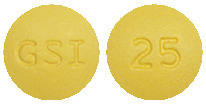
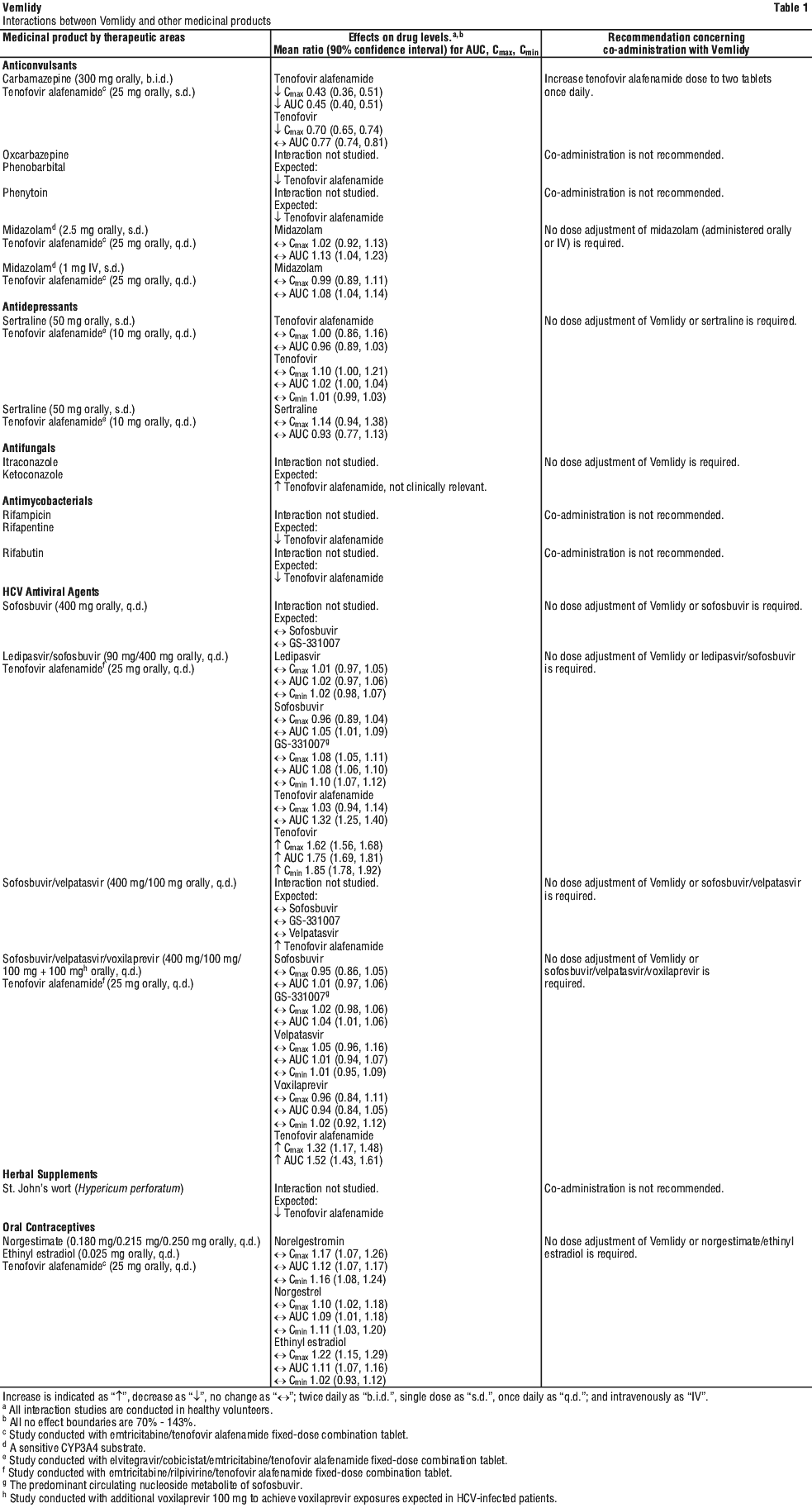
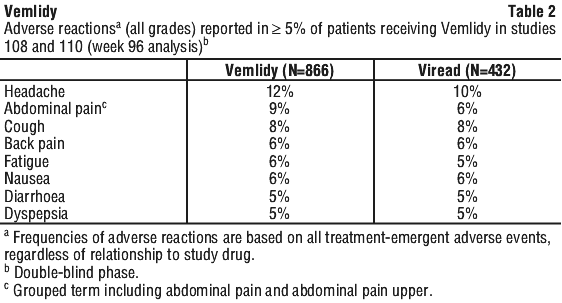 Additional adverse reactions occurring in greater than 1% to less than 5% of patients in Studies 108 and 110 included vomiting, rash, and flatulence.
Additional adverse reactions occurring in greater than 1% to less than 5% of patients in Studies 108 and 110 included vomiting, rash, and flatulence.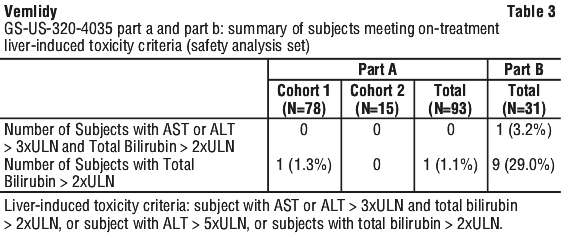
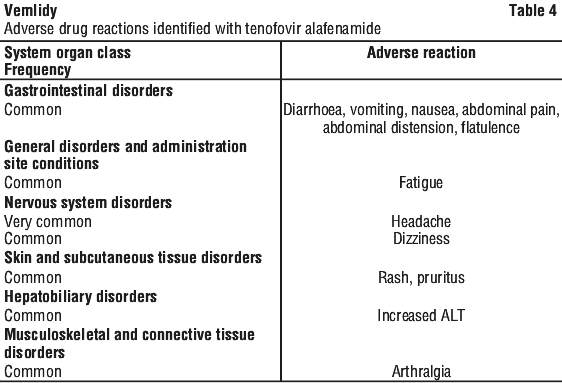
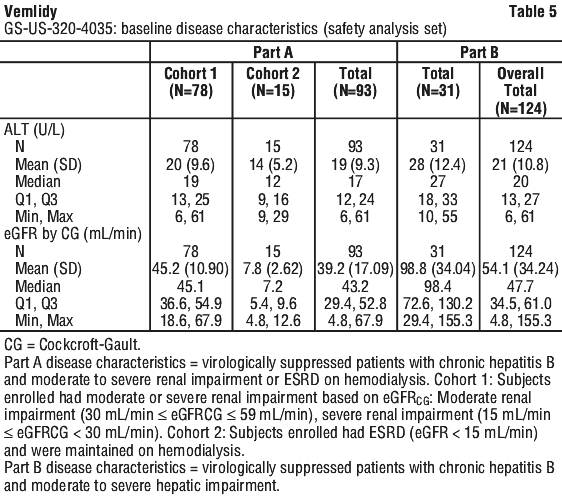
 Vemlidy met the non-inferiority criteria in achieving HBV DNA less than 29 IU/mL when compared to Viread at Week 48. At Week 96, similar efficacy was demonstrated with Vemlidy compared to Viread.
Vemlidy met the non-inferiority criteria in achieving HBV DNA less than 29 IU/mL when compared to Viread at Week 48. At Week 96, similar efficacy was demonstrated with Vemlidy compared to Viread.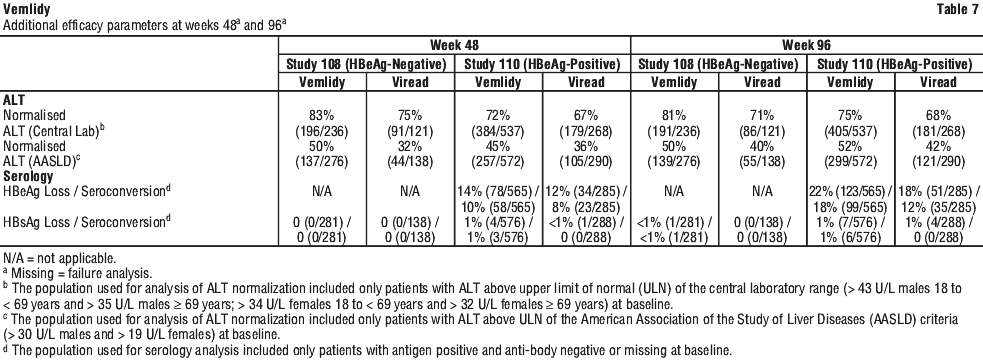
 In patients who remained on blinded treatment beyond Week 96 in Studies 108 and 110, mean percentage change in BMD as assessed by DXA in each group at Week 120 was similar to that at Week 96. In the open-phase of Studies 108 and 110, mean percentage change in BMD from Week 96 to Week 120 in patients who remained on Vemlidy was +0.6% at the lumbar spine and 0% at the total hip, compared to +1.7% at the lumbar spine and +0.6% at the total hip in those who switched from Viread to Vemlidy at Week 96.
In patients who remained on blinded treatment beyond Week 96 in Studies 108 and 110, mean percentage change in BMD as assessed by DXA in each group at Week 120 was similar to that at Week 96. In the open-phase of Studies 108 and 110, mean percentage change in BMD from Week 96 to Week 120 in patients who remained on Vemlidy was +0.6% at the lumbar spine and 0% at the total hip, compared to +1.7% at the lumbar spine and +0.6% at the total hip in those who switched from Viread to Vemlidy at Week 96. In patients who remained on blinded treatment beyond Week 96 in Studies 108 and 110, change from baseline in renal laboratory parameter values in each group at Week 120 were similar to those at Week 96. In the open-label phase of Studies 108 and 110, the mean change (±SD) in serum creatinine from Week 96 to Week 120 was -0.002 (0.10) mg/dL in those who remained on Vemlidy, compared to -0.008 (0.09) mg/dL in those who switched from Viread to Vemlidy at Week 96. In the open-label phase, the median change in eGFR from Week 96 to Week 120 was -0.6 mL/min in patients who remained on Vemlidy, compared to +1.8 mL/min patients who switched from Viread to Vemlidy at Week 96.
In patients who remained on blinded treatment beyond Week 96 in Studies 108 and 110, change from baseline in renal laboratory parameter values in each group at Week 120 were similar to those at Week 96. In the open-label phase of Studies 108 and 110, the mean change (±SD) in serum creatinine from Week 96 to Week 120 was -0.002 (0.10) mg/dL in those who remained on Vemlidy, compared to -0.008 (0.09) mg/dL in those who switched from Viread to Vemlidy at Week 96. In the open-label phase, the median change in eGFR from Week 96 to Week 120 was -0.6 mL/min in patients who remained on Vemlidy, compared to +1.8 mL/min patients who switched from Viread to Vemlidy at Week 96.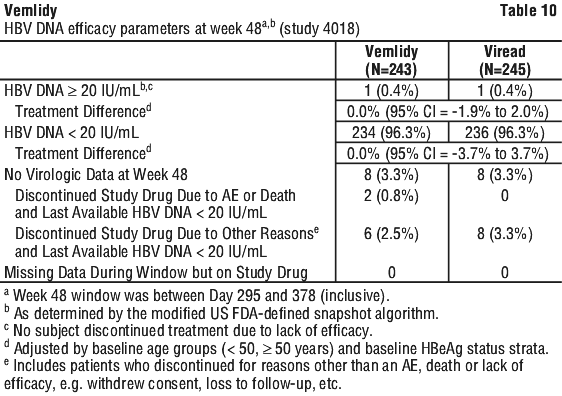 Vemlidy was noninferior in the proportion of subjects with HBV DNA ≥ 20 IU/mL at Week 48 when compared to Viread as assessed by the modified FDA Snapshot algorithm. Treatment outcomes (HBV DNA < 20 IU/mL by missing=failure) at Week 48 between treatment groups were similar across subgroups by age, sex, race, baseline HBeAg status, and ALT. See Table 11.
Vemlidy was noninferior in the proportion of subjects with HBV DNA ≥ 20 IU/mL at Week 48 when compared to Viread as assessed by the modified FDA Snapshot algorithm. Treatment outcomes (HBV DNA < 20 IU/mL by missing=failure) at Week 48 between treatment groups were similar across subgroups by age, sex, race, baseline HBeAg status, and ALT. See Table 11.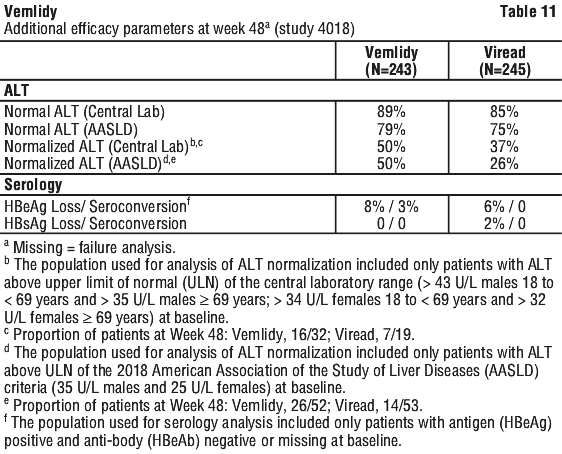
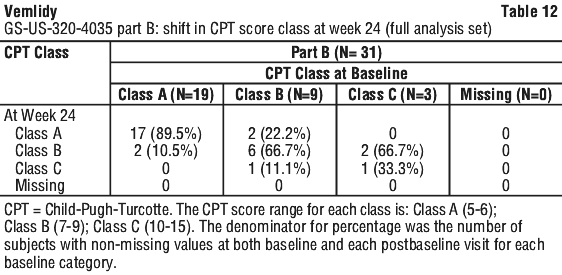
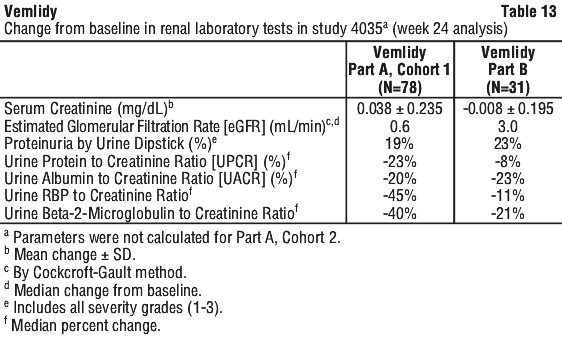
 Tenofovir alafenamide fumarate is a white to off-white or tan powder with a solubility of 4.7 mg per mL in water at 20°C.
Tenofovir alafenamide fumarate is a white to off-white or tan powder with a solubility of 4.7 mg per mL in water at 20°C.